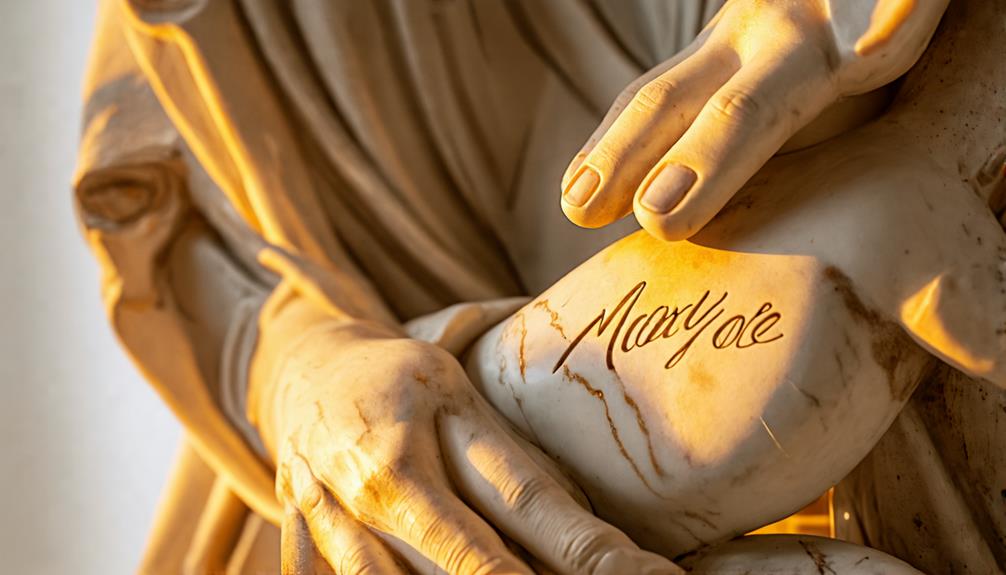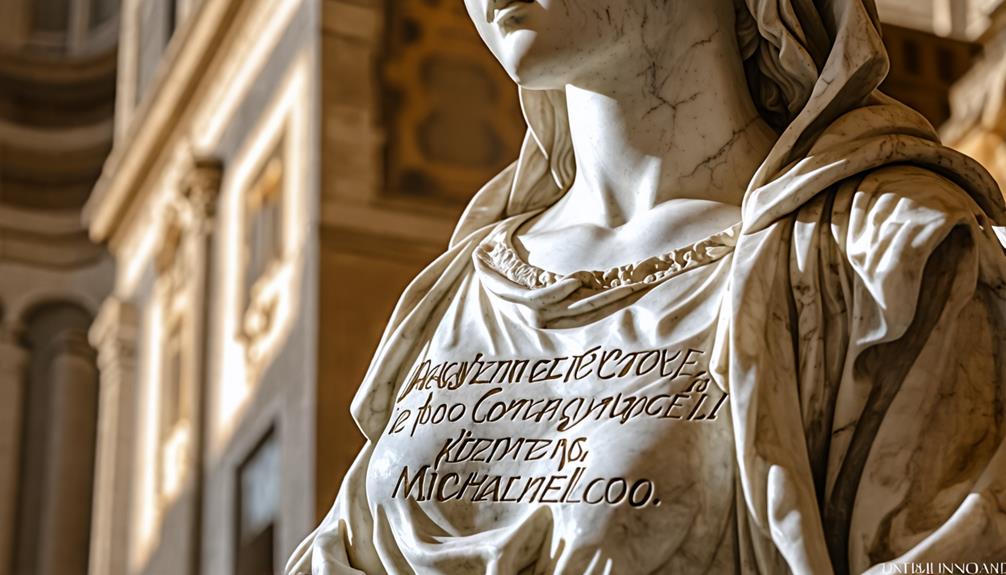You've probably heard of Michelangelo's iconic works, from the Sistine Chapel ceiling to the statue of David. But did you know that among his vast collection of masterpieces, he only signed one? It's a curious fact that raises questions about artistic attribution and recognition during the Renaissance. Why would such a prolific and renowned artist choose to leave most of his works unsigned? The answer lies in the changing dynamics of the art world during this transformative period, and it's a story that sheds light on the evolving relationship between artists, patrons, and the public. There's more to this tale than meets the eye…
Key Takeaways
- Michelangelo only signed his Pietà sculpture, completed in 1499 when he was 24 years old.
- The signature appears on Mary's sash, reading "MICHÆLANGELUS BONAROTUS FLORENTINUS FACIEBAT."
- Michelangelo signed the Pietà in response to critics attributing the work to another sculptor, Cristoforo Solari.
- This singular signature marks a shift from artistic anonymity to individual recognition during the Renaissance.
The Singular Signed Masterpiece

Among Michelangelo's vast body of work, only one piece bears his signature: the Pietà, completed in 1499 when he was just 24 years old. This masterpiece of the Italian Renaissance, carved from Carrara marble, depicts the Virgin Mary cradling the body of Christ. You'll find Michelangelo's signature carved into Mary's sash, reading 'MICHÆLANGELUS BONAROTUS FLORENTINUS FACIEBAT.'
The young sculptor signed his creation after overhearing critiques attributing it to another artist, Cristoforo Solari. This act marked a pivotal moment in art history, signifying a shift from anonymous artisanship to established individual artistic identity.
Curiously, Michelangelo never signed another piece of art after the Pietà, perhaps reflecting his growing confidence in his unmistakable style. The Pietà remains a tribute to his early genius and a unique example of his signed art.
Renaissance Artist Recognition Evolution
During the Renaissance, you'll witness a profound shift in how society viewed artists, transforming them from anonymous craftsmen to celebrated individuals with unique creative visions. This evolution in art history is epitomized by figures like Michelangelo Buonarroti, whose artistic identities became synonymous with genius and creativity.
As artists gained recognition, they began asserting their individual authorship through signatures on their work. Michelangelo's decision to sign the Pieta, his only signed work of art, reflects this changing landscape. You'll notice that signing artworks became an essential tool for Renaissance artists to establish their reputations in a competitive field.
This period marked a turning point in how society perceived artists, elevating them to the status of intellectuals. The increased appreciation for individual creativity during the Renaissance forever changed the relationship between artists, their works, and the public.
Legacy of Unsigned Works

Anonymity shrouds many Renaissance masterpieces, yet their enduring influence on art history remains undeniable.
You'll find that excellent painters like Leonardo da Vinci and Raphael often kept their counsel, leaving numerous works unsigned. Despite this, their legacy of unsigned works speaks volumes through distinct styles and techniques.
Consider 'The Last Supper' or 'Mona Lisa' – both attributed to da Vinci without his signature. These pieces have achieved global recognition, demonstrating that a work of art's impact isn't diminished by lack of authorship.
Interestingly, Michelangelo only signed one piece: the Pieta. He feared his work should be attributed to someone else, even bringing his chisels along to carve his name.
This act marked a shift in artist recognition, yet the unsigned masterpieces of the Renaissance continue to captivate audiences and shape our understanding of art history.
Conclusion
You've discovered that Michelangelo's singular signed work, the Pietà, stands out among his vast collection of unsigned masterpieces.
This unique signature reflects the evolving recognition of artists during the Renaissance.
As you explore Michelangelo's legacy, remember that his unsigned works are no less valuable or authentic.
They're a demonstration of his humility and dedication to art for its own sake, rather than personal glory.
His genius shines through, signature or not.

Leave a Reply